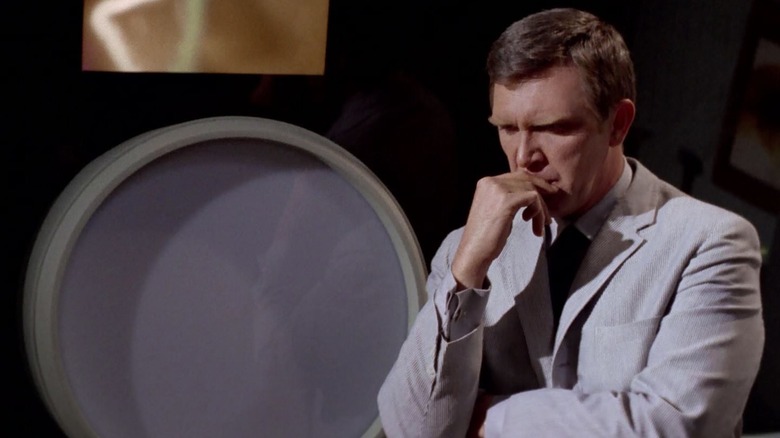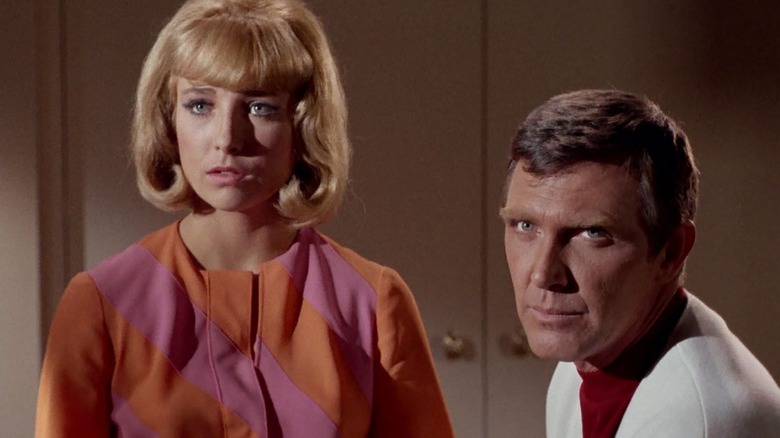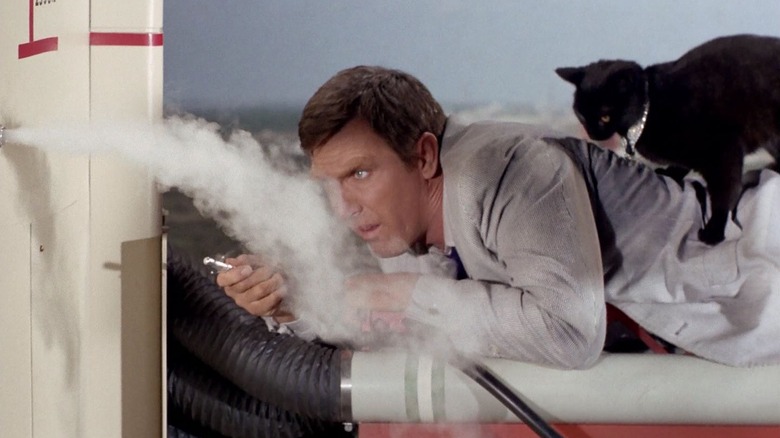Star Trek's First Failed Spin-Off Had A Longer Lifespan Than You Knew
We may receive a commission on purchases made from links.
Most Trekkies would be able to tell you that the original series "Star Trek" episode "Assignment: Earth" was meant to be a backdoor pilot. "Assignment: Earth" heavily featured a then-new character named Gary Seven (Robert Lansing) a time-traveler from the 24th century. Gary Seven was discovered by the crew of the U.S.S. Enterprise after it had traveled back to the 20th century for research purposes.
Kirk (William Shatner) and Spock (Leonard Nimoy) briefly interact with Gary, but the bulk of the episode focuses on his adventures and the sci-fi widgets he has at his disposal. Gary carries around a futuristic, screwdriver-like device he calls a Servo and can teleport around Earth through a high-tech portal built into a vault in his office. He's accompanied by Isis — a cat who, in a mysterious turn of events, transforms into a humanoid woman (April Tatro) — and eventually gets a modern-day human sidekick named Roberta (Teri Garr), a secretary who stumbles upon his fantastical cave.
At the end of its second season, the future of "Star Trek" was still in doubt. A letter-writing campaign was the only thing that saved it from being canceled, forcing NBC to give the show a third season. If "Star Trek" had failed, though, creator Gene Roddenberry had "Assignment: Earth" as a backup series all ready to go. Hence, when "Star Trek" was rescued, plans for the Gary Seven TV show were shelved. It was the last time anyone would hear of Gary Seven until (bafflingly) an episode of (the very cluttered) "Star Trek: Picard" in 2022.
Of course, since Trekkies love expanded universe lore, Gary Seven did have a life outside of official "Star Trek" canon. The character has appeared in numerous comic books and was mentioned in several of the extant "Star Trek" novels. The Gary Seven TV series might've never come to be, but we kind of got one anyway.
Gary Seven appeared in other Star Trek projects after his TV show was abandoned
Gary Seven had a pretty interesting backstory. He was born on Earth in the year 4,000 BCE, but was abducted by time traveling aliens who raised him on a distant world. He then grew up and took a job with a time-travel bureau, earning the title of Supervisor. Specifically, he was Supervisor 194. Because Roddenberry wanted to leave more to explore for a potential spinoff, he left the broader details of Gary Seven's life vague on "Star Trek." Trekkies have never learned how, for instance, Isis could transform from a cat into a humanoid woman.
In novel form, however, Gary Seven lived on. From 2001 to 2006, Pocket Books published three novels in the "Eugenics Wars" series, a Greg Cox-penned trilogy centered on the life of Khan Noonien Singh (the character played by Ricardo Montalbán in "Space Seed" and "Star Trek II: The Wrath of Khan"). The first two books in the trilogy ("The Rise and Fall of Khan Noonien Singh" Volumes 1 and 2) detail Khan's life from childhood in the 20th century up to the events of "Space Seed." Trekkies can tell you that Khan was a tyrant who ruled great swaths of Earth during the destructive Eugenics Wars. When he was finally overthrown, Khan fled Earth on a ship called the Botany Bay, whereon he and some compatriots entered cryogenic stasis. He was thawed many years later during the events of the "Space Seed" episode.
It seems that Gary Seven was a key figure in Khan's life. According to Cox's novels, Khan was grown in a eugenics lab in 1974. The lab was going to be destroyed, but Gary rescued Khan and his fellow augments, hoping to use their superior strength and intelligence to usher in a new age of peace on Earth. This is a pretty big deal in "Star Trek" lore.
The Star Trek novels revealed Gary Seven and Khan had a complicated relationship
The relationship between Khan and Gary Seven got even more complicated. It seems that Khan was too ambitious for Gary's utopian plans, feeling instead that he should rule the world, not serve it. As such, he and Gary ended up alienating one another. Gary also tried to stop Khan from instigating the Eugenics Wars, but was unsuccessful. They raged for years. When the Wars started to go south for Khan, it was Gary who, feeling compassionate, provided him with the Botany Bay before retiring in the wake of the entire kerfuffle.
Gary Seven was also featured in Cox's 1998 novel "Assignment: Eternity," an enjoyable time-travel story in itself that took place shortly after the events of "Assignment: Earth." It seems Gary, having learned that Spock was going to be assassinated in about a century, traveled to the year 2269 (which is about when "Star Trek" season 3 takes place) to stop the assassination plot before it could start. (Roberta was there too.) "Assignment: Eternity" also asserted that Gary helped reduce the effects of the Three Mile Island disaster, stopped an assassination attempt on the life of Chairman Mao, and exposed the Watergate scandal. In a fun additional crossover tease, Gary said that he worked with a pair of sexy British intelligent agents, implying that "Star Trek" and the '60s spy show "The Avengers" take place in the same universe.
Gary and Roberta were also featured in a five-issue comic book mini-series published by IDW in 2008. This was after a few guest appearances in the DC-backed line of "Star Trek" comics published from 1993 to 1996. For DC, though, Gary only ever dropped in for an issue or two; he didn't stick around.
While he wasn't officially canonical again until "Star Trek: Picard," some authors — Greg Cox in particular — were fond of Gary Seven. It seems to me that a new Gary Seven TV series could easily be made for Paramount+.


